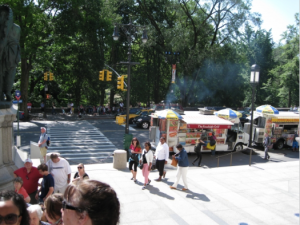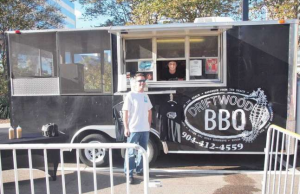Giving customers the option to pay how they want is a simple way to improve the customer experience, ideally increasing loyalty and sales. But as many small businesses, including food trucks, have found — paperless forms of payment like mobile payments can pay off far beyond convenience. Increased payment options can boost overall revenue for a concession businesses too. This post explains why you should consider adding payment options beyond cash.
How Multiple Payment Options Can Improve Your Bottom Line
Utilize the equipment you use daily.
Before mobile payments gave customers the option to pay using a credit or debit card on a smartphone or tablet, businesses had to invest in a fixed point-of-sale terminal system to accept any form of payment other than cash. These setups were not only costly but also bulky, taking up valuable space in a food truck, where every inch counts.
Today, the only thing most food trucks need to accept credit cards is a mobile-payment-equipped smartphone or tablet. With portable payment systems like Square, Clover Go, and PayPal Here, food truck operators can process payments wirelessly.
According to Kristen Gramigna, Chief Marketing Officer for Clover, “The ability to take payments on the go has transformed the way small businesses, including food trucks, operate. It’s fast, efficient, and most importantly, allows merchants to meet customers wherever they are.”
These mobile devices also free up much-needed space, giving truck owners more flexibility to focus on their cooking equipment and menu rather than bulky cash registers. And your customers? They won’t miss the old-school register either.
Expanded Payment Options Drive More Sales
Cash may once have been king for food trucks, but today’s customers expect more. In addition to credit and debit cards, many customers now prefer contactless payment options, such as Apple Pay and Google Wallet. These methods offer an extra layer of convenience and security, as customers can simply tap their phones or watches to pay.
Additionally, food trucks that use platforms like Venmo and Cash App are capitalizing on peer-to-peer payments, which are popular among younger demographics. Food truck owners have found these apps to be particularly effective at festivals and events where patrons often don’t carry cash.
“Giving customers more payment options is not just a matter of convenience; it’s a way to boost your bottom line,” said Miguel Sanchez, a food truck operator in Austin, Texas. “We saw a 15% increase in sales after adding mobile payments and apps like Venmo.”
Improved Sales with Reduced Perceived Wait Times
Whether it’s a weekday lunch rush or a bustling weekend event, long lines can deter potential customers. But did you know that it’s not always the actual wait time that matters? According to a Duke University study on wait times and sales, customers’ willingness to wait is often based on their perception of how quickly the line is moving, rather than the actual time spent waiting.
With mobile payments, food trucks can speed up the payment process, creating a smoother customer experience. For example, setting up multiple lines—one for orders, another for payments, and a third for pickups—can keep things moving. By utilizing mobile payment options, your staff can even go into the line to process payments before the customer reaches the window.
Electronic Receipts Save Time and Paper
Paper receipts have long been a staple for food truck operators, but they can be cumbersome, requiring additional hardware and paper rolls. Now, more food trucks are offering electronic receipts, sent via email or text message. This option not only reduces waste but also offers added security for customers, who don’t need to worry about losing a paper receipt.
Additionally, digital receipts can make it easier for business professionals who might be submitting their meal expenses for reimbursement. They can simply forward the email receipt to their accounting department, avoiding the hassle of keeping track of physical copies.

Accepting Multiple Forms of Payment Can Increase Revenue For Almost Any Concession Vehicle.
Catering to the Cashless Customer
Many food trucks operate in cash-light environments, such as corporate parks or festivals, where customers may not have access to an ATM. Mobile payments allow food trucks to serve this cashless crowd. With platforms like Stripe and Square, customers can even pre-order and pre-pay online, ensuring a faster and more seamless experience at pickup.
“People love the convenience of ordering ahead,” said Sarah Thompson, owner of a food truck in Portland, Oregon. “During peak hours, it helps us manage the flow of customers, and it’s a big hit with our regulars who don’t want to wait.”
By advertising that you accept mobile payments, you can attract more customers who prefer a cash-free experience.
Other Payment Options to Consider


Built by M&R Specialty Trailers and Trucks
In addition to the more traditional credit, debit, and mobile wallet options, here are some other payment methods food trucks might consider:
- QR Code Payments: Allow customers to scan a QR code that takes them directly to a secure payment page, eliminating the need for a card or even a mobile wallet.
- Prepaid Cards: Some food trucks sell branded prepaid cards that regular customers can use to make purchases.
- Gift Cards: Offering gift cards or digital gift codes can be another way to encourage repeat business and make gifting easier for your fans.
- Cryptocurrency: While still niche, some forward-thinking food trucks are experimenting with accepting cryptocurrencies like Bitcoin. This could appeal to tech-savvy or early adopter customers.
Customers are beginning to expect the option. Consumers are becoming increasingly accustomed to the idea of mobile payment — especially for smaller transactions like those made for food or coffee. As Nation’s Restaurant News reported, throughout 2014, leading quick service and fast food restaurant brands like Taco Bell, Subway, Wendy’s and Chick-fil-A have taken notice, and all made steps to embrace mobile payment platforms. Though mobile payments and mobile wallet technology has been slower to catch on in the U.S. versus some European countries, the amount of innovative leaders like Google and Apple that are now part of the mobile payments sphere have turned the payment method mainstream.
Expanding Payment Options to Improve a Taco Trucks Bottom Line
Take Carlos Perez, who runs a taco trailer in Austin. He swears by the moment he added contactless payments like Apple Pay and Google Wallet. “People don’t carry cash anymore,” he says. “They’ve got their phone and their card, and that’s it. Once we accepted those options, it was game over.” The results? Carlos saw a 20% boost in sales within the first month of adding mobile payments. “We used to lose customers who’d show up with no cash. Now, we don’t turn anyone away.”
Adding payment options doesn’t just cater to forgetful customers, though. It speeds up the whole process. When you’re running a taco trailer during the lunch rush, every second counts. By offering mobile payments, Carlos and his team could process transactions faster than with the old-school cash method. “We used to have one line where people would order and pay,” he says. “Now, we set up a second line just for people paying with their phones. They don’t even need to pull out a card—it’s tap, and they’re out.”
Electronic receipts were another bonus. Instead of printing paper receipts that customers often crumple and throw away, Carlos’s taco trailer sends them via text or email. “Our regulars love it,” he says. “They don’t have to dig through their wallet for a receipt if they’re expensing lunch—it’s already in their inbox.”
And it’s not just about the standard card or phone payments. Carlos’s team decided to dip a toe into Venmo and Cash App—and the younger crowd loved it. “At events or festivals, it’s perfect. People already have Venmo open, splitting a round of beers. They just keep the app open to pay for their tacos too,” Carlos explains.
Some food trucks have even started accepting cryptocurrency, tapping into the tech-savvy crowd. While it’s not as common yet, Carlos says he’s seen a few trucks in Austin trying out Bitcoin payments for fun. “It’s not for everyone, but those who use it, love that option. And hey, if you’re a taco lover with Bitcoin, who am I to say no?”
So, the lesson? Whether you’re running a taco trailer or a burger stand, opening up new payment avenues isn’t just smart—it’s essential. “You’ve gotta meet people where they are,” Carlos adds. “For some folks, it’s about convenience, but for us? It’s all about not losing a sale.”




